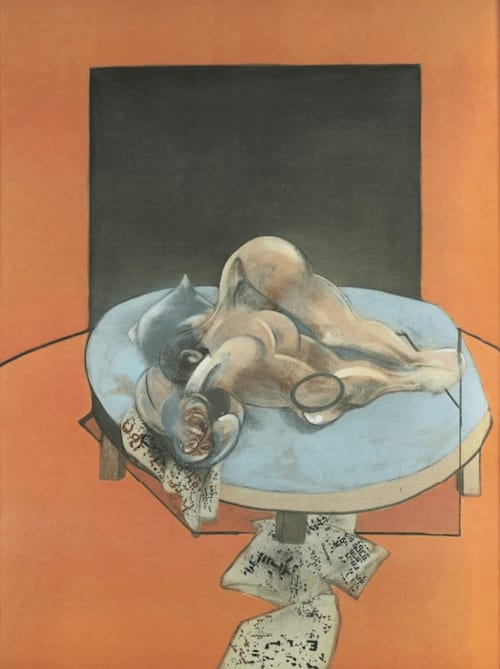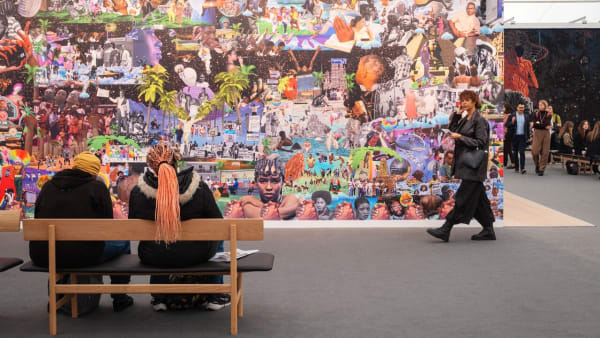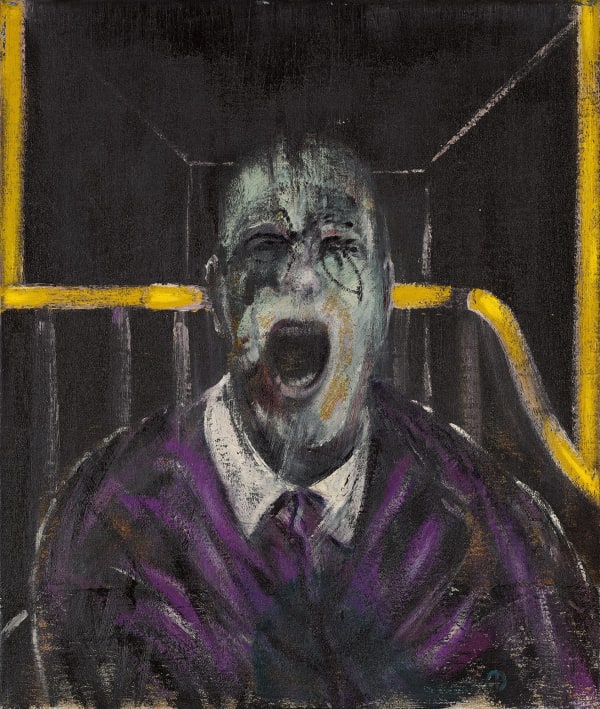-
Francis Bacon Prints For Sale.
Francis Bacon's art is a deep exploration of the human condition told through the revolutionary lens of a true genius. His distorted and contorted figures explore aspects religion, mythology & the deeply personal. Explore our latest Francis Bacon prints for sale at Guy Hepner, Bacon dealers since 2007.
Discover authentic Francis Bacon signed prints for sale below.
-
Works

Francis Bacon
Studies of the Human Body , after the Central Panel of the Triptych Studies of the Human Body 1979, 1980Offset lithograph on Arches paper40 x 26 in
101.5 x 66 cmEdition of 250Copyright The ArtistStudies of the Human Body , after the Central Panel of the Triptych Studies of the Human Body 1979, 1980 by Francis Bacon offers a deeply introspective and haunting vision...Studies of the Human Body , after the Central Panel of the Triptych Studies of the Human Body 1979, 1980 by Francis Bacon offers a deeply introspective and haunting vision of the self, continuing a powerful trajectory of self-portraiture that became a central focus of his later career—particularly throughout the 1970s and 1980s. During this period, Bacon increasingly turned inward, grappling with themes of ageing, mortality, and psychological isolation. This work exemplifies that shift, presenting a fragmented, emotionally charged reflection of the artist’s inner world rather than a traditional likeness.
Bacon’s figure is seated in an unnaturally twisted pose, embodying both physical discomfort and emotional strain. The head—distorted, deformed, and partly disintegrated—appears to collapse in on itself, dissolving the boundaries between flesh and space. This manipulation of anatomy, a signature of Bacon’s visual language, conveys not only the vulnerability of the human body but also the instability of identity itself. The face is not rendered for recognition; rather, it is constructed as a psychological battleground, where anguish, memory, and self-doubt converge.
The surrounding environment reinforces this emotional isolation. The figure is set against a stark, minimalist backdrop of pale blue and sandy beige, tones that evoke both calm and clinical detachment. The emptiness of the space accentuates the solitude of the figure, stripping away any contextual markers that might suggest comfort or connection. Instead, the sparse setting heightens the sense of psychological exposure. A single diagonal line cuts across the composition, dividing floor from wall with surgical precision. This sharp geometric intrusion adds to the disorienting atmosphere, reinforcing a feeling of confinement, as if the figure exists in a space between dimensions—neither fully grounded nor entirely free.
Bacon’s palette is subdued yet calculated. The soft, cool hues of the background are contrasted with the dark, bruised tones of the figure’s body. This juxtaposition underscores one of the key tensions in the work: the contrast between outward composure and inner turmoil. The placid setting might suggest stillness or peace, but the distorted form disrupts any sense of serenity. This interplay between external calm and internal chaos is a recurring motif in Bacon’s self-portraits, capturing the psychological contradictions that define human existence.
By the 1980s, Bacon was acutely aware of his own mortality. Many close friends and lovers, including George Dyer—whose suicide in 1971 deeply scarred Bacon—had died, leaving the artist increasingly isolated. This emotional solitude echoes throughout After Study for Self-Portrait, not only in its formal composition but in its existential tone. The work does not seek to immortalize the artist through idealization; rather, it confronts the decay and fragility of the self with brutal honesty. The figure appears not as a coherent whole but as a fragmented, fading presence—a body and identity under siege.
More than a self-portrait, this piece functions as a psychological excavation. Bacon uses the language of distortion, abstraction, and isolation to articulate profound human fears: the fear of ageing, the fear of death, and the fear of dissolving into irrelevance. There is no vanity here, no search for legacy—only the raw confrontation with impermanence. In doing so, Bacon turns the act of self-portraiture into a theatre of existential reckoning.
Ultimately, After Study for Self-Portrait stands as a poignant reflection on the artist’s late style: a culmination of decades spent dissecting the body, emotion, and identity. It captures not only Bacon’s unique visual language but also his enduring preoccupation with the unstable nature of selfhood. This work, like others in his later self-portraits, transcends biographical specificity to become a universal meditation on what it means to exist—to endure the erosion of time, to confront oneself in isolation, and to find meaning in the fractured mirror of the human condition.
For more information on Francis Bacon’s Studies of the Human Body , after the Central Panel of the Triptych Studies of the Human Body 1979, 1980 or to buy Francis Bacon’s Studies of the Human Body , after the Central Panel of the Triptych Studies of the Human Body 1979, 1980 contact our galleries using the form below.Overview"The job of the artist is always to deepen the mystery".
Francis Bacon is one of the most important artists of the 20th century and post-war movements. Arguably one of the finest and most celebrated artists of his generation, Bacon holds a pivotal role in contemporary art through his revolutionary approach to his craft. One of the great explorers of the human condition Francis Bacon and his art, touch on fateful mix of mythology, religion, love and death, and document our joys, sorrows and pains perhaps better than any other artist before or since.
The imagery of Bacon is one of pure expression rejecting the prevailing artistic style of abstraction of the era, in favor of a distinctive and disturbing realism and his distorted forms convey a sense of both beauty and despair. The dichotomy in Bacon’s prints and imagery can be seen through his raw use of violent, yet delicate colors as well as the marriage he makes between the figurative and abstract. It is this soft balance between the brutal and the subtle, the violent and the soft and happiness and anguish that make Francis Bacon’s art so important and collectible. A master of painting, and known for his large scale canvases, Bacon combines seemingly disparate tectures, colours and forms to ceate a whirlwind of emotion conveying and reaching the heart of his subjective matter. Equally so Franci Bacon's print output, often as apres, lithographs or signed prints, offer his most popular subjects including Pope Francis and his famous triptychs.
Whether new to collecting Francis Bacon prints or an experienced collector, Guy Hepner can help. Since 2007 we have assisted clients across the world to buy Francis Bacon prints in confidence. Whether iconic triptych, lithographs or apres, our experienced and knowledgeable team are on hand to help you achieve your collecting goals. From our New York and London galleries, offer a wide selection of authentic Francis Bacon prints for sale.
Contact info@guyhepner.com for our latest Francis Bacon prints for sale or to buy Francis Bacon original art. News
News-

London’s Frieze Week Record Breakers
A Guide to a Blockbuster Week of Sales October 20, 2025London’s marquee auction houses just concluded a blockbuster week of contemporary art sales, coinciding with the Frieze art fair. In a series of evening auctions...Read more -

A Collector’s Guide to Francis Bacon Prints
Why Collect Bacon March 14, 2025Francis Bacon remains one of the most powerful and influential artists of the 20th century. His raw, visceral works depicting the human form in distorted,...Read more




